Do As Facebook Says, Not As It Does
This week, David Carr writes about Facebook’s increasingly psychodramatic relationship with publishers, who, whether or not they’ve actively catered to the site, have come to depend on it profoundly. The column also carries a bit of news, which has been circulating as a likely theoretical for the last year or so, but which now seems to be real:
The company has been on something of a listening tour with publishers, discussing better ways to collaborate. The social network has been eager to help publishers do a better job of servicing readers in the News Feed, including improving their approach to mobile in a variety of ways. One possibility it mentioned was for publishers to simply send pages to Facebook that would live inside the social network’s mobile app and be hosted by its servers; that way, they would load quickly with ads that Facebook sells. The revenue would be shared.
There are publishers who have been waiting for this opportunity. Some are small, and already depend entirely on Facebook for distribution — they are not, by any familiar definition, diverse news publications. Some are large, and see a short-term opportunity: They’re already optimizing for Facebook with “TRENDING NEWS” teams and the like, so they would be glad to remove any friction between their most viral posts and the cascading feed at which they were intentionally angled. Direct publishing could be a way to directly monetize this ᴄᴏɴᴛᴇɴᴛ, and to counteract a Facebook-driven dilution of traditional ad rates for websites. Or even to sell ads against posts a second time, to a different audience (first on your site, then on Facebook’s site).
One way to look at this, which situates Facebook neither as an evil force colonizing publishing nor as a lumbering dumb beast grabbing at everything around it, is to try to see what kind of example it’s setting. Facebook — the company, not the site — has spent the last few years diversifying. It spent many billions of dollars on a messaging app that was already successful; it spent a couple billion on a virtual reality helmet that it finds promising. It bought Instagram, watched it grow larger than Twitter, and then filled it with ads. It threw weight behind Facebook-adjacent internal projects, such as Slingshot, Paper, and Rooms, none of which have caught on, not that it matters yet — Facebook has a lot of cash and at least some time to figure out its next contraption to convert human attention into money.
Implicit in this behavior is an acknowledgment that Facebook proper, the News Feed, is not the future of the company. It’s how it makes most of its money now, and next year, and who knows for how many years after that. But Facebook, a large company run by competent people, is attempting to plan against the unforeseeable and the inevitable. It’s leaders don’t know for sure what’s coming next, but they know they need to be a part of it. They know that preferences change and tides turn and that their old site, the single feed of photos and updates and links from a mishmash of friends and family and coworkers assembled over a decade, the first hugely successful smartphone platform but definitely not the last, will eventually give way to something else. This is a sensible way to look at the world, if you are Facebook. Or if you are any company on the internet!
Facebook, a company with lots of cash and great short-term prospects, is diversifying its company as fast as it possibly can. At the same time, it is asking publishers — many of whom have very little cash and uncertain short-term prospects — to do the opposite. It’s asking publications to go all-in, or to raise their bets on Facebook substantially. It is asking to do as Facebook says, not as it does.
Near the end of Carr’s column, Facebook offers its customary assurances:
Chris Cox, chief product officer for Facebook, knows that the frightened chatter is out there, but says those worries are unfounded because the interests of Facebook and digital publishers are pretty much aligned.
If this is true, that Facebook believes its priorities to be aligned with those of publishers,* then publications should consider what will happen when this ceases to be the case — when Facebook, like virtually every large tech company that has survived for more than five years, changes forms, finds its next cash cow, stops paying attention to News Feed, and puts its partners out to pasture. (Or if it fails!)
For the most eager partners, the ones who were first in line, the ones who had the most faith in the alignment of their priorities with the big friendly tech company’s, the ones who reaped the most, in the beginning, from Facebook’s content rush: What, by then, will be left of your publication? Or, if you’re not so romantic, of your business?
*Of all the Facebook employees I’ve spoken to, none have made a convincing case that this is true or even held to be true within the company. In most cases it has not been clear that there is a widespread understanding within Facebook of its power over internet publishing and news. For a great number of Facebook employees, web publishing is either one more advertising opportunity or a minor engineering problem — a source of slow-loading links that must be optimized. Facebook’s priorities were “aligned” with Zynga, too.
ᴄᴏɴᴛᴇɴᴛ ᴡᴀʀs is an occasional column intended to keep a majority of ᴄᴏɴᴛᴇɴᴛ coverage in one easily avoidable place.
Meet the New Ebola Experts
President Obama to meet with ebola nurse. will shake hands with ebola nurse. will hug ebola nurse. will pat on head. good ebola nurse good
— Rich Lowtax Kyanka (@lowtax) October 27, 2014
WELCOME TO NEW JERSEY AND NOW GET IN THE TENT, DOCTOR:
On Friday, in a surprising move, Gov. Andrew M. Cuomo of New York and Gov. Chris Christie of New Jersey imposed a mandatory quarantine on individuals arriving at two area airports who have had direct contact with those infected with Ebola, including health workers.
Among medical professionals who have been fighting Ebola in West Africa, the restrictions only intensified the debate. While a few of those interviewed said an overabundance of caution was welcome, the vast majority said that restrictions like those adopted by New York and New Jersey could cripple volunteers’ efforts at the front lines of the epidemic.
Of the diminishing ways to assert yourself as a tough, clear-minded politician, fed up with the bullshit and ready to Get Things Done
, enacting a mandatory Ebola quarantine for new arrivals from affected countries seems like an attractive choice. Fear of the disease combined with the impression that it is somehow a foreign pathogen, rightfully belonging to other people, means that any decisive plans with the word “Ebola” in them will quickly find public support. (1985: “A majority of Americans favor the quarantine of AIDS patients.”)
The only problem with this plan is that medical professionals are not sure it makes any sense at all.
Dr. Rick Sacra, who contracted Ebola in Liberia and was flown back to the United States to be treated in September, said he believed that the new rules in New Jersey and New York would reduce the number of people willing to volunteer their time to treat Ebola patients.
So a doctor, who also happens to be a former Ebola patient, publicly suggests to Andrew Cuomo and Chris Christie that their tough-on-infection posturing might in reality do more harm than good. If we grant that the quarantine discussion is above all a PR battle, this still seems like it might be a problem. That would be a misreading:
Americans’ trust in the medical profession has plummeted in recent years, and lags well behind public attitudes toward doctors in many other countries, according to a new report…
Just 34 percent of U.S. adults polled in 2012 said they had “great confidence in the leaders of the medical profession,” down from 76 percent in 1966, according to the report.
This is slightly higher than America’s polled “Trust in Government,” but not by enough to matter.
It’s not about what you know, or what you’ve done. It’s about how much confidence you inspire in the people who are paying the least attention.
Ebola Panic in Small-Town New Jersey
by John Stillman

The Peasant Grill in sleepy Hopewell, New Jersey, is a popular destination for hot drinks, baked confections, and sandwiches. It’s usually packed during lunch hour, but it’s been relatively empty since October 9th, when a black Mercedes with a woman wearing black sunglasses behind the wheel pulled up and disgorged a man, who went inside and picked up an order of soup. Some days later, the woman’s name, her children’s names, and the address of her home — a short drive from The Peasant Grill — appeared on posters hung on the public boards throughout downtown Princeton:
HELP PROTECT OUR COMMUNITY FROM:
EBOLA
NBC TODAY SHOW
TV CELEBRITY
NANCY SNYDERMAN
Dr. Nancy Snyderman is NBC’s chief medical editor, a correspondent on several of the network’s shows, a surgeon, a businesswoman, the author of five books, and number thirty on the Reader’s Digest ranking of Most Trusted People in America. Earlier this month, Dr. Snyderman visited Monrovia, Liberia, to report on the ongoing Ebola epidemic; she was exposed to the disease by her cameraman, Ashoka Mukpo, who had become infected with the virus. (He was transported to a hospital in Nebraska, where he recovered after two-and-a-half weeks of treatment.) Upon returning to the U.S., Dr. Snyderman agreed to a self-imposed quarantine in her home until 11:59 on October 22nd, according to an NBC memo (the same night that a Manhattan doctor named Craig Spencer, despite feeling slightly under the weather, would go bowling in Brooklyn). But on the Thursday after her quarantine began, she was sighted in public on the now-infamous soup run.
The first case of Ebola in New York City was a sensation, but not a surprise; big cities around the world have been treating such cases as an inevitability. Princeton-Hopewell, however, was not expecting Ebola. Its specter did not loom over this relatively pastoral town. “I felt bad for everybody in Texas,” the manager at Boro Bean, a cafe located five doors down from The Peasant Grill, told me. “And then Nancy comes for soup!”
Though the Peasant Grill’s owners have refused to publicly comment on the matter, one longtime customer said that the establishment has received harassing phone calls since Dr. Snyderman’s soup run. Another recent lunchtime patron said that people drove by and shouted “harassing things at people who are just trying to eat there and have a good time.” Fancying myself and my constitution invulnerable to such scare tactics, I visited the restaurant on a recent Friday afternoon. I can confirm that the chicken barley soup, which comes with a dunkable crostini on the side, is definitely worth the risk.
It had been eight days since Dr. Snyderman’s still-unidentified soup-fetcher darkened the Peasant Grill’s doors, and business was still suffering noticeably. A young woman at the Peasant Grill used the opportunity to Windex the glass in the restaurant’s front door. Once they sparkled, she came inside. “I think we’re safe,” she said.
“We’re good?” Michelle, the owner, asked.
“No more fingerprints,” the employee said.
A customer entered, ordered a sandwich, and offered his condolences to Michelle. “They’re saying that a lot of hysteria just creates a lot of uncertainty in the world,” she said.
“It’s crazy, right?” the customer said. “I don’t get it.”
Considering the circumstances, the novelty signs on display in The Peasant Grill seemed to augur the eventual visitation of such a curse. “Mental Ward,” read one behind the counter. By the register, a souvenir-size tablet read, “Life is all about how you handle plan b.”
In the bathroom, there was a framed notice:
Employees must wash or remove hands before returning to work
Just a little Health Department quirk.

Everything that comes in contact with an Ebola patient must be incinerated. Protection begins with basics pic.twitter.com/XDbOEMxssU
— Dr. Nancy Snyderman (@DrNancyNBCNEWS) October 1, 2014
By Dr. Snyderman’s own reckoning, she posed “no risk,” but this assessment was difficult to trust from someone so close to the situation — someone who had just returned from what she referred to in a tweet as “the belly of the beast for Ebola.” While there, and assumedly in in close contact with Mukpo, she tweeted, “Everything that comes in contact with an Ebola patient must be incinerated. Protection begins with the basics.”
People did not expect Dr. Snyderman to self-incinerate, but they did expect her to follow the CDC’s protocols and chill out at home for three weeks. Her failure to abide by the quarantine — the most basic protocol of all — was not taken lightly. “Why didn’t Dr. Snyderman have any regard for people?” Barbara Ficarra of the Huffington Post asked. “They want transparency and honesty; they don’t want someone taking advantage of their elite status.” A family practice physician from Ohio started a Change.org petition calling for NBC to fire her; another petition asked the Obama Administration to “arrest Dr. Nancy Snyderman for 318,883,000 counts of premeditated attempted murder for Ebola quarantine violation.” This latter effort garnered four signatures. Middle-aged people took to Snyderman’s Facebook profile to post things like “Shame on you!”
When the state of New Jersey, in conjunction with the CDC, upgraded her quarantine from voluntary — which hadn’t meant that it was optional, just self-imposed — to mandatory, the Princeton Police Department began monitoring her neighborhood. Initially, this was to ensure that she did not escape again. But later, Sgt. Steven Riccitello clarified in an interview that the police patrol was motivated by concerns that fear-mongers would take matters into their own hands. “As a national figure, she could be the target of threats to her family,” Sgt. Riccitello said. “We look at Nancy as a citizen. We’re here to keep the peace.”
Strolling along the main streets of Princeton and Hopewell, it seemed like Riccitello has been perhaps too successful in doing so: It was dead quiet. Workers at Da’s Thai restaurant, Hopewell Valley Bistro and Inn, and Boro Bean, all said that business just hasn’t been the same in the two weeks since Dr. Snyderman blew through. At Jack and Charlie’s, a Hopewell Central High senior scooping ice cream said that his friends’ parents, dismayed by the whole ordeal, had called it “a bloody mess,” which it was not yet, thankfully. A congregant of a local church told me that one fellow parishioner objected to the hand-holding circle ritual that customarily concludes group meetings. “And these are educated people!” the woman said.
Of course, even the best education — or even a medical degree — does not make you immune to hysteria, or necessarily properly equip you to respond to close contact with Ebola. I couldn’t get a taxi to come to Hopewell during rush hour, so I hitchhiked and landed a ride back to Princeton with a pastor who said that he had once been in the entertainment industry. He claimed to have worked at ABC during Dr. Snyderman’s tenure there, and remembered that she had a reputation for stubbornly insisting on doing things her way. “That’s the irony of it,” he added. “She’s a doctor.”
John Stillman is a freelance journalist. He used to enjoy bowling.
New York City, October 23, 2014

★
For a while, off in the northwestern distance, there was one rumpled gap of brightness behind the gray rain. Then gray covered all. The rain dripped more vigorously down through the grate onto the subway tracks than it had been falling above. Downtown, the rain had wind behind it and was heavy enough to require the umbrella, allowing the discovery that one arm had snapped and gone dangling. The darkness held all day. By the time the rain stopped, it was too cold to duck out onto the fire escape, even with a jacket.
Hobbits Take Flight Once Again In The Most Epic Safety Video Ever Made
by Awl Sponsors
Brought to you by Air New Zealand
In anticipation of the December release of The Hobbit: The Battle of the Five Armies, Air New Zealand takes flight once again with Dwarves, Orcs, and Elves in The Most Epic Safety Video Ever Made.
Wrapping off a successful and exciting three-year collaboration with The Hobbit film series, Air New Zealand brings some of the Trilogy’s most beloved cast and crew, such as Elijah Wood (Frodo Baggins), Dean O’Gorman (Fili the Dwarf), Sylvester McCoy (Radagast) and director Sir Peter Jackson, to a number of New Zealand’s Middle-earth locations for this in-flight safety video. Passengers, alongside other creatures from the Trilogy, embark on an epic journey through Middle-earth from their own seat.
The Most Epic Safety Video Ever Made follows up the airline’s first Hobbit-inspired safety video, The Unexpected Briefing (2012).
Check out the video to discover how Air New Zealand can help make your journey to Middle-earth one you sure won’t soon forget. Then visit airnewzealand.com for the best offers to get you there.
A Poem by Danniel Schoonebeek
by Mark Bibbins, Editor
Works and Days
Hesiod insists his name means the shovel.
And this life on my spade
“it will end
in two acts.”
ACT ONE
Before I grow up
& I die a legend to nobody
ACT TWO
I’ll grow up
get poorly
& ghost write
my brother’s life story.
•
They called it 1983 when they triggered me.
And mom coughed me up —
a fist of white drugs on a patch of dead leaves in the timothy.
Supposed to be:
a child was born on this day with a badger brush in his teeth end of story.
But the badger before she is skinned
& the bristles
long after the skinning
each to each we have yearns of our own
& the brush
in my mouth it kept foaming.
•
Yes I followed a girl like a goat who drooled wine from her mouth into mine.
Yes life named this the new millennium, not me.
•
And the man from the Party with the bombardier look on his face & gold cheekbones
you reek he said
like a mutt
with a face that
could cook
up a fundraiser.
They called her Red Dirge their flag & they drove her stake through my chin.
And I bore her
in rivers of grain up to their podium.
I gazed out at the townies my name
on their pickets
my campaign
awareness money
hanging like mouthfuls of haggis from the citizenry’s pockets.
•
(Go, let history tell you.)
•
“He didn’t even have the balls to vote party line.”
•
“I want to smoke me
out of me,” I thundered.
“Like this name you’re calling me is a rodent who’s wintering
no summering
inside the fifty
dividing walls of my ancestry’s body.”
•
Thence I lived a short life the haunch of a joke.
(Rain, gunfire, crows).
•
Five years thence I was famously addicted to whiskey dick & for the umpteenth time in my life
when I smelled the sal volatile
I turned raw
I skinned my head on the sky & woke up in custody
& the poorly cropped
local police they’re a dynasty
& they beat the classified ads from teeth like they were sifting a jewel from a feed bag.
•
No second acts in American lives
sings Hesiod
whose asshole is always bleached white as a daylily.
And no gun to go off neither.
Simply me, said my brother in the middle of his life in an elk lodge.
•
I’ll never forget the telephone poles of my youth, he said.
Mudpuppies under the flagstones, he said.
And my enemies
how I loved them
when they ambushed me inside the bamboo.
•
Hesiod insists
act two
will be fin
when I tell you the jaws of life’s what they needed
when they needed to pry a girl from the mud
with the balls
to wedlock my brother.
Problem being.
Life when you land it
is a low-paying job.
And act three’d already begun with no mud.
•
I have chosen the life of no wants, I tell them.
My house it’s not even one thimble.
Jarfuls of piss
my father’s
they wait
like a trust fund
stacked high
as a plateful
of haggis
down cellar.
I was sent to this village to die in this village.
Now my village
is an ingrown
hair on my dick.
It soothes me the chafing when the head lice rut in the dumpsters.
And the rednecks drive cocked
off the bridge
to the cock fights.
In this village I can hear a mosquito suck blood from the chin of a hireling.
And a hireling
suck dye from a lollipop.
You dynasty men.
You come to my door once a year & sucking your teeth with a summons.
I’ll wire you
what I wired god
when god told me
“eat dust
& find work.”
The man’s not been born who can stop me from slumming.
The mayor he owes me the keys to the village.
And I’ll live here the rest of my life.
Danniel Schoonebeek’s first book of poems, American Barricade, is out now from YesYes Books. In 2015, Poor Claudia will publish his second book, a prose travelogue called C’est la guerre.
You will find more poems here. You may contact the editor at poems@theawl.com.
Not Just Any Apple
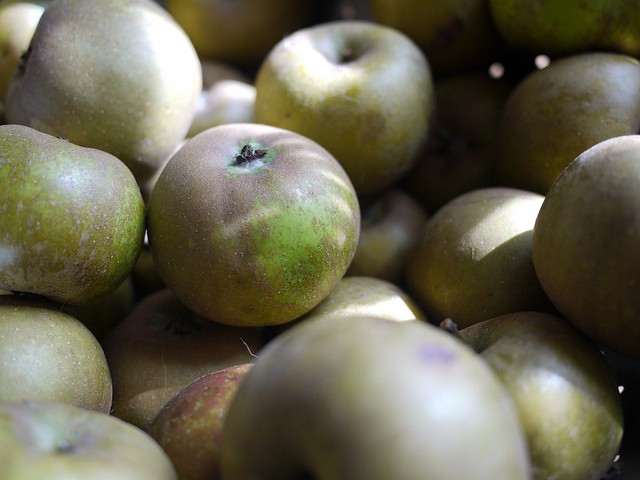
New York has the best apples in the world. I say this grudgingly, since I am not a native New Yorker and prefer to argue about claims to New York’s superiority rather than accept them. But after four years of living in this ridiculous city, the facts are the facts: Washington may grow many more apples each year; Minnesota may have the best apple laboratories; and apples (well, besides crab-apples) may not even be native to this continent; but in terms of flavor and variety, I’ll hold up New York’s apples against anywhere in the world. That said, you’re probably buying the wrong ones.
I won’t even bother to dismiss the Red Delicious apple, still the most popular variety in the country; Sarah Yager at the Atlantic did a better job with that than I could. Instead I want to encourage New Yorkers, and other people who live in states which I’m sure do other things well but do not grow apples quite as well as New York, to try the ugly apples — the cheap and rough and blemished and unfamiliar apples.
Lately, it is not the red delicious that’s raised my ire, but the Honeycrisp, an apple developed just a few decades ago in labs in Minnesota. The Honeycrisp is an excellent walking-around apple, a hardy variety that lasts for weeks off the tree and boasts a spectacularly crisp texture. Perhaps no other apple boasts the *snap* of a Honeycrisp. But at the farmers market I see customers walk past a dozen other varieties in favor of the Honeycrisp, and this saddens me, for two reasons. First, the Honeycrisp is not especially flavorful; its sweetness and tartness is well balanced, but it lacks the punch-in-the-face apple flavor of other varieties. Second, it’s very expensive; a grower I know in Pennsylvania refers to them as “Moneycrisps” because he can charge two or three times as much for them as for other varieties, though it’s not really any harder to grow.
Now, if I’m in a grocery store and the choices are Red Delicious, Granny Smith, and Honeycrisp, I’d usually opt for the Honeycrisp. But not in New York, in the fall! Not when there are literally hundreds of heirloom varieties out there, crazy apples with flavors of pear and pineapple and spice and with a huge range of colors and textures. Branch out! Try the ones you’ve never heard of!
My current favorites are the Golden Russet and the Suncrisp. The former has russetting — a brown, rough-textured skin, like an Asian pear — which has been deemed unacceptable by new apple breeders, who assume that consumers aren’t interested in a dull, matte brown apple when gorgeous red-gold apples will be sitting in the next bin over. And yet: the Golden Russet is outstandingly flavorful, powerfully sweet and with a hint of nuttiness and almost a molasses flavor. It also has a good, firm texture (I have yet to find a mealy one). It’s an old variety probably created right here in New York, somewhere in the Hudson River Valley, and it is spectacularly delicious.
The Suncrisp is a near opposite of the Golden Russet: It, like the Honeycrisp, was created in labs only recently — this one at Rutgers in New Jersey. It’s a hybrid of the Golden Delicious (big, very sweet, not at all related to the Red Delicious) and a cross of the Cortland and Cox’s Orange Pippin, the latter of which is an excellent heirloom variety in its own right. The Suncrisp is a good transition from the Honeycrisp; it’s just as crisp, but the flavor is richer and more complex. Where the Honeycrisp has a sort of berry flavor, the Suncrisp is more like pineapple or some other tropical fruit. (I know these wine-tasting-like descriptions are pretentious and irritating but I have to get you people to buy interesting apples somehow, right?)
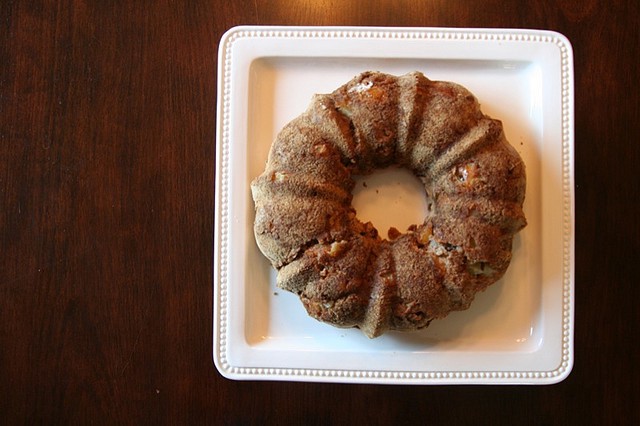
Cooked apples are something else entirely. Usually you cook them down pretty thoroughly, so texture isn’t quite as important — what you’re looking for with a cooking apple is the most intense possible flavor. This first recipe is an actual recipe, with actual measurements, because it isn’t mine; it’s my dad’s. It’s a Jewish apple cake, with caramelized apples, almost like a pineapple upside-down cake. It is excellent despite being a kosher dessert. I thought this was an old Jewish recipe, passed down for generations from the old country, but I called home to find out and apparently my dad just, like, got it off the internet about ten years ago and modified it slightly. It is, weirdly enough, a very common cake in Pennsylvania, where my parents live, probably with German roots. It is mostly sold there as a “German apple cake.” Anyway, here it is, written in my words rather than his because I’m a professional blogger and my dad is merely an accomplished and decorated research chemist.
Put three cups flour, a tablespoon of baking powder, a tablespoon of salt (his recipe calls for a teaspoon, but I like more salt than he does), two cups of brown sugar, four eggs, two and a half teaspoons of vanilla extract, a cup of canola oil, and a quarter cup of orange juice into a big bowl, and mix thoroughly. If you have a stand mixer, use it; if not, this is your exercise for the week. When smooth, pour half of the batter into a bundt cake pan. (I’ve used regular baking dishes with this and it doesn’t quite turn out right — you need more surface area for the edges of the cake to get crispy.)
Then make yourself some cinnamon sugar: about two teaspoons of cinnamon to three-quarters cups of brown sugar. (I only use brown sugar; I think my dad uses white, but he’s wrong.) Sprinkle about a quarter of this cinnamon sugar evenly over the batter’s surface, then layer down two apple’s worth of apple slices. My favorite apple for this is the Jonathan, an easy-to-find apple that I don’t much like eating raw, since its texture runs from not-particularly-crisp to mushy and mealy. But it has a huge flavor, and bakes really, really well. Anyway, lay those down, then sprinkle another quarter of your cinnamon sugar on top of the apples. Then pour the rest of the batter into the bundt pan, and do the same thing with the apples: cinnamon sugar, two apples’ worth of apple slices, cinnamon sugar. Bake at 300 degrees for seventy-five to ninety minutes, and use a cake tester like this one to tell when it’s done. It should be moist in the middle, but not wet.
As a lazy cook with zero patience or talent for baking, I make this cake maybe once a year at most. Instead, I most often make an apple crisp, because it’s less precise and you don’t actually have to measure anything. (Note: the differences between crisps, crumbles, buckles, and grunts are vague. I’m calling this a crisp, because that’s what I call it, but if it’s technically something else feel free to yell at me in the comments.) Take out a cast iron skillet and put it on medium heat, and throw in about a third of a stick of butter. Chop up five apples. I prefer thin slices that are then cut in half width-wise, but you’re going to be cooking them for so long you can pretty much do whatever you want. (This will seem like too much apple, but they’re going to reduce in size a lot.) As far as type of apples, I prefer Golden Delicious derivatives: Mutsu, Cameo, Opal, Pink Lady. Throw the apples in the pan and stir to cover them in butter, then add a pinch of salt, a small spoonful of honey, and a sprinkle of allspice. Stir again, cook if for a couple minutes to let the honey mix with the butter and the allspice toast, then add about a cap-full of apple cider vinegar. Turn the heat down to medium-low and let the apples cook for awhile, until they’re still distinct slices (you don’t want applesauce) but are soft.
While that’s happening, make your topping. In a big bowl, mix about two cups of regular rolled oatmeal (not Irish oats or quick-cook oats), a tablespoon of salt, a couple teaspoons of cinnamon, and about a cup of brown sugar, then take the rest of your stick of butter and mash it into your dry stuff. Cold butter is best; you want to form kind of blobs, not a uniform topping. I usually use my hands for this, just kind of squeezing the butter into the dry stuff until it’s all gone. When the apples are done, kind of shake the pan so they’re all spread evenly in there, then lay down your topping in a single layer on top of the apples, then slide the whole thing in a 350 degree oven until the topping is crisp and doesn’t taste like raw oats anymore, which could take between forty-five minutes and an hour. Serve with vanilla ice cream.
Apples can work in savory dishes, but they’re usually restricted to serving as sweet-sour accompaniments to pork, which is really more of a pork dish than an apple dish, or fall salads with raw apples — the sort with big chunks of fennel or kohlrabi or (christ) raw kale, and pecans or whatever (which are basically desserts with vegetables in them). I’d rather combine chicken with apples for a real simple braise, which I’ve simplified even further from this Serious Eats recipe. Get some cheap chicken parts with bones and skin, like legs or drumsticks, and pat them dry. Put a little bit of oil in your dutch oven or other big pot and sear the chicken on all sides until browned but not cooked through, then remove the chicken and stick ’em on a paper towel somewhere. In the rendered chicken fat, saute a chopped apple and a chopped red onion until softened, then pour in about a cup of hard apple cider (something more on the dry side, but probably not too funky), a pinch or two of salt, and a grind or two of pepper. Drink the rest of the apple cider while you stir to get all the sticky bits off the bottom of the pot. Then stick the chicken parts back into the pot, cover it, and turn the heat down to low. The chicken’s done when it falls off the bone. Serve over rice or mashed potatoes. If you want to step that recipe up, you could remove the chicken when done and work with the braising liquid a bit; some honey, some mustard, some sage, some smoked paprika, reduce it a bit more, maybe add in a roux (equal parts flour and fat), before pouring over the chicken. I usually don’t bother. It’s pretty good without all that stuff.
Apples are the one thing that unites everyone living in the parts of the country with garbage weather — the Northeast, the Midwest, and the Pacific Northwest. They are the one argument we can lob at those dickheads in California, who can grow anything in any month: Sure, you can grow tomatoes in February, but can you grow a good apple? Nope. Only we can.
Crop Chef is a column about the correct ways to prepare and consume plant matter, by Dan Nosowitz, a freelance human who enjoys hot salads and lives in Brooklyn, naturally.
Photos by Rebecca Siegel and Ali Edwards
Checking in with the Ebola Day Traders
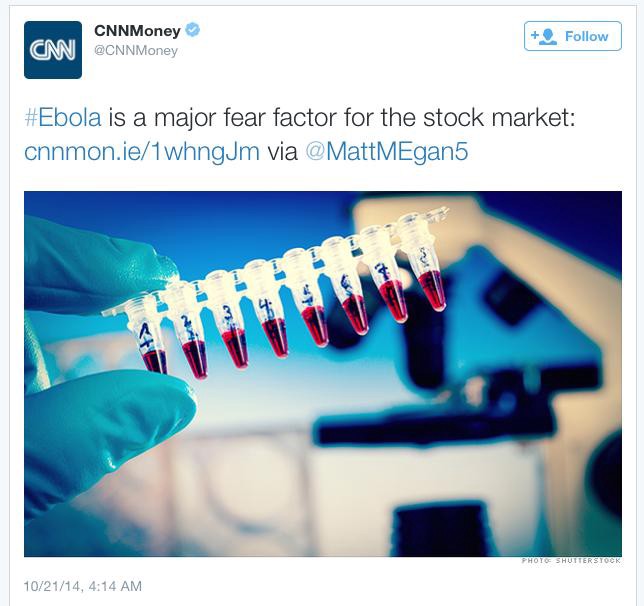
A few days ago, there was a sense among the addled death-shorting Twitter community that “Ebola stocks” — by then shorthand for a specific set of companies that mostly make protective equipment — weren’t a great investment. Sure, demand for their products must be up, and their prospects for making money must have improved, but their ability to rain down hot cash on fast-clicking maniacs was diminished. Of course the existence of a horrible virus that has killed thousands of people and will kill thousands more is categorically bad news, but that’s beside the point. What isn’t beside the point, is a better question to ask of our financial markets.
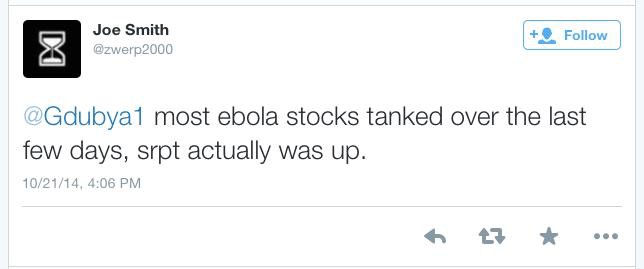
There was now mostly unease and regrouping, after a legendary (among Twitter day traders) run on Ebola stocks following the cases in Texas.
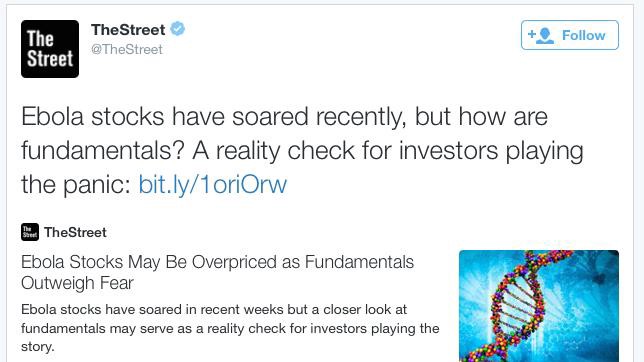
The subject, which days earlier hosted thousands of messages, had been overtaken by spam.

The day traders were either ignoring the stocks or thinking about shorting them. Many apparently did.

But then, mid-afternoon, a tremor.
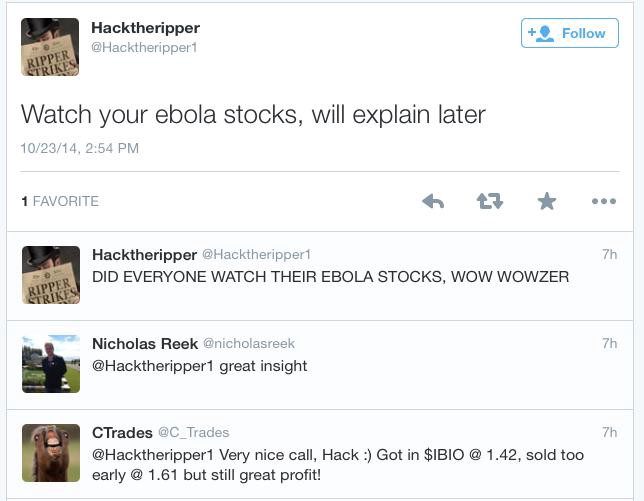
Capital: it carries news quickly!
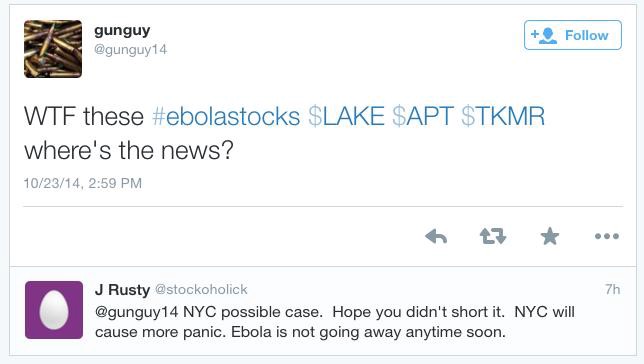
Once the Ebola traders figured out what was going on, it was a bonanza.
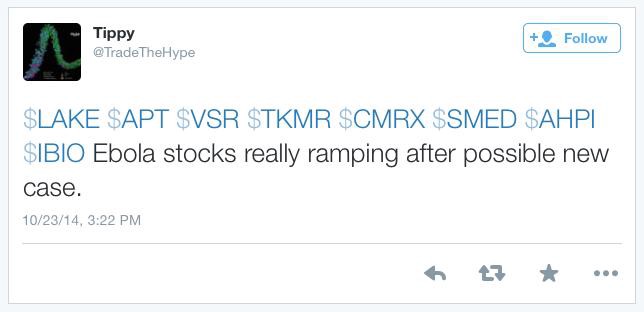
Some people got left behind.
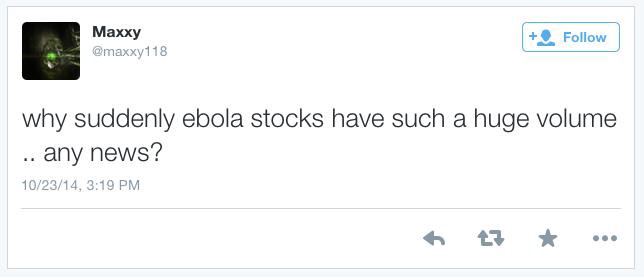

Plenty of people didn’t.
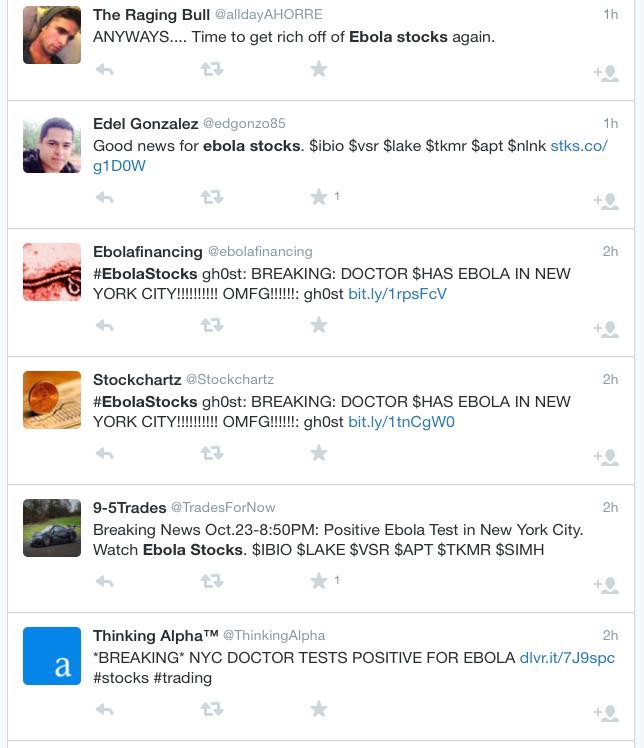
Acknowledging the cynicism of this whole enterprise is only acceptable if you accompany your observation with solid buying advice.
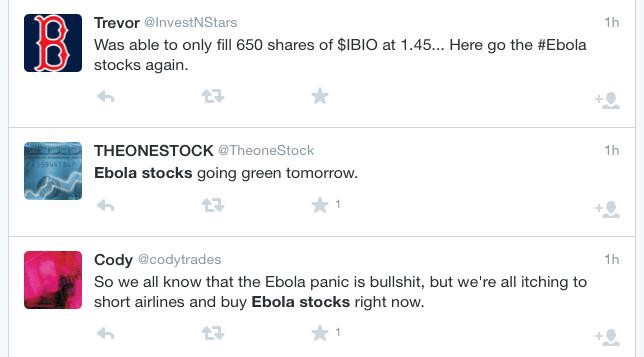
There was a degree of sympathy on display. Not for the man with Ebola, of course, but for the fools who were short on Ebola stocks.

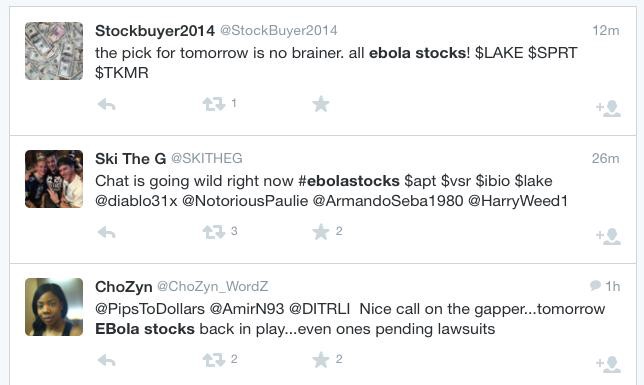
And so here we are. Ebola doctor: You chose to help those in need, and you are now suffering for it. For this — specifically for the suffering part — the viral day traders thank you.
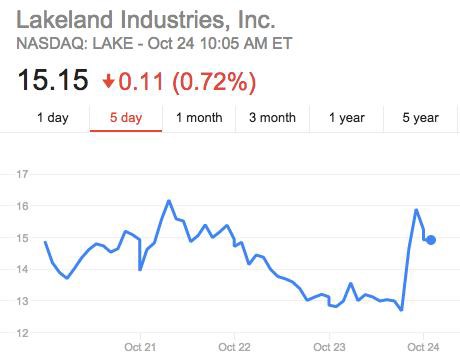
Screaming Females, "Wishing Well"
A walk-around-with-headphones track that rummages through a drawer of twenty-year-old chord progressions and flourishes and somehow comes up with exactly what it needs.
New York City, October 22, 2014

★ Discouraging rain, dark and soaking. The plastic cover for the stroller had picked up a crust of thick black grime as it rode around unused in the bottom cargo basket. The rain eased off and came back on again. Outside the barbershop, a bent cigarette, dropped half-finished, trailed smoke eastward low over the wet sidewalk. A turn of the chair and it had burned out. It was too cold out on the office fire escape to duck out for a break without a jacket. The rain made sure to come on heavily again for rush hour. Little golden leaves made crumbling jetties or failing dams in the gutters.
